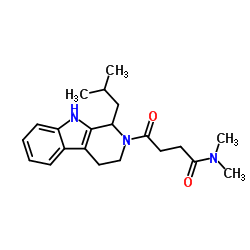Role of individual cysteine residues and disulfide bonds in the structure and function of Aspergillus ribonucleolytic toxin restrictocin.
S K Nayak, D Rathore, J K Batra
Index: Biochemistry 38(31) , 10052-8, (1999)
Full Text: HTML
Abstract
Restrictocin, produced by the fungus Aspergillus restrictus, belongs to the group of ribonucleolytic toxins called ribotoxins. It specifically cleaves a single phosphodiester bond in a conserved stem and loop structure in the 28S rRNA of large ribosomal subunit and potently inhibits eukaryotic protein synthesis. Restrictocin contains 149 amino acid residues and includes four cysteines at positions 5, 75, 131, and 147. These cysteine residues are involved in the formation of two disulfide bonds, one between Cys 5 and Cys 147 and another between Cys 75 and Cys 131. In the current study, all four cysteine residues were changed to alanine individually and in different combinations by site-directed mutagenesis so as to remove one or both the disulfides. The mutants were expressed and purified from Escherichia coli. Removal of any cysteine or any one of the disulfide bonds individually did not affect the ability of the toxin to specifically cleave the 28S rRNA or to inhibit protein synthesis in vitro. However, the toxin without both disulfide bonds completely lost both ribonucleolytic and protein synthesis inhibition activities. The active mutants, containing only one disulfide bond, exhibited relatively high susceptibility to trypsin digestion. Thus, none of the four cysteine residues is directly involved in restrictocin catalysis; however, the presence of any one of the two disulfide bonds is absolutely essential and sufficient to maintain the enzymatically active conformation of restrictocin. For maintenance of the unique stability displayed by the native toxin, both disulfide bonds are required.
Related Compounds
| Structure | Name/CAS No. | Molecular Formula | Articles |
|---|---|---|---|
 |
Restrictocin
CAS:1406-72-0 |
C21H29N3O2 |
|
The ribotoxin restrictocin recognizes its RNA substrate by s...
2011-04-12 [Biochemistry 50(14) , 3004-13, (2011)] |
|
Mechanism of specific target recognition and RNA hydrolysis ...
2001-08-07 [Biochemistry 40(31) , 9115-24, (2001)] |
|
Electrostatic interactions guide the active site face of a s...
2008-08-26 [Biochemistry 47(34) , 8912-8, (2008)] |
|
[Antibody detection in patients with invasive aspergillosis]...
2004-01-01 [Mycoses 47 Suppl 1 , 55-9, (2004)] |
|
Expression of an epitopic region of AspfI, an allergen/antig...
1999-12-01 [Immunol. Lett. 70(3) , 151-5, (1999)] |